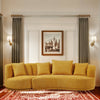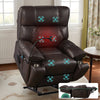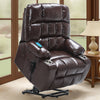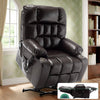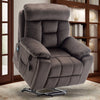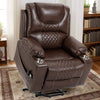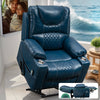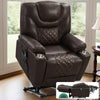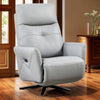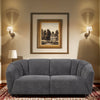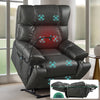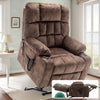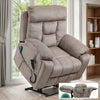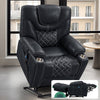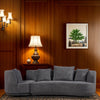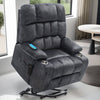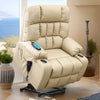Understanding the Functional Requirements of a Living Room
Identifying the Primary Uses of the Space
Living rooms serve many purposes in modern homes. They're places for relaxation, entertainment, and socializing. To design an effective space, consider how you use it most often. Do you watch TV, read, or host gatherings? List your top activities. This helps prioritize furniture and layout choices. For example, if you often have guests, ample seating is crucial. If you work from home, a small desk area might be needed. Remember, a well-designed living room adapts to various needs. It should be comfortable for daily use and ready for special occasions.

Balancing Aesthetics with Ergonomics and Comfort
A beautiful living room is great, but comfort is key. Choose furniture that looks good and feels good. Ergonomic designs support proper posture and reduce strain. Soft, plush fabrics invite relaxation. Consider the height and depth of seating options. They should suit different body types. Lighting plays a role too. It should be adjustable for various activities. Color schemes can affect mood and comfort. Warm tones create a cozy atmosphere. Cool colors can make a space feel larger and calmer. The goal is a room that's visually pleasing and physically comfortable for everyone.
Assessing the Impact of Design on Family Dynamics and Lifestyle
Your living room design can greatly influence family interactions. An open layout encourages togetherness and conversation. Separate seating areas allow for individual activities. Consider how furniture placement affects traffic flow and communication. A centrally placed square sectional can create a focal point for family gatherings. Adjustable seating, like power lift recliners, caters to different needs and ages. This inclusivity is important for multigenerational homes. Think about storage solutions to keep the space tidy and functional. A clutter-free room promotes relaxation and positive family dynamics. Your design choices should reflect and support your family's lifestyle and values.
Maximizing Space and Flexibility with Square Sectionals
Selecting the Right Square Sectional for Your Living Room
Square sectionals offer versatility in living room design. They provide ample seating and can define spaces in open floor plans. When choosing, consider the room's size and shape. Measure your space carefully to ensure a good fit. Look for modular options that can be rearranged. This allows for easy reconfiguration as needs change. Pay attention to the sectional's depth and height. These affect comfort and visual impact. Fabric choice is important too. Durable, stain-resistant materials work well for busy families. Leather offers a luxurious look but requires more maintenance. Color should complement your existing decor. Neutral tones provide flexibility for changing styles over time.

Creative Ways to Organize Square Sectionals in a Small Space
Small living rooms can benefit from square sectionals too. Use corners to maximize seating without wasting space. Consider L-shaped configurations that hug walls. This leaves the center open for movement. Some sectionals come with built-in storage, perfect for compact areas. Try floating the sectional in the middle of the room to create distinct zones. Use a slim console table behind it as a room divider. Opt for sectionals with longer sides to double as a guest bed. Lighter colors and raised legs can make the piece appear less bulky. Don't forget about vertical space. Wall-mounted shelves above the sectional add storage without using floor space.
The Role of Sectionals in Hosting Versatile Events
Square sectionals shine when it comes to hosting events. Their modular nature allows for easy rearrangement. Create conversation areas for parties or open up space for dance floors. Some sectionals have removable ottomans. These can serve as extra seating or coffee tables. During movie nights, a sectional provides cozy seating for the whole family. For game nights, adjust the configuration to face a central table. When hosting overnight guests, many sectionals convert to beds. This dual functionality is a space-saver in smaller homes. The right sectional can adapt to various social situations, making your living room event-ready at all times.
The Best Adjustable Seating Options for a Power Lift Recliner
The Benefits of Adjustable Seating in Multifunctional Living Rooms
Adjustable seating, especially power lift recliners, offer numerous benefits. They provide personalized comfort for users of all ages and abilities. The lifting mechanism aids those with mobility issues. This feature promotes independence and safety. Adjustable positions cater to various activities like reading, watching TV, or napping. Many models offer massage and heating functions for added relaxation. These features can help with pain relief and circulation. In multifunctional rooms, adjustable seating adapts to changing needs throughout the day. They can transform from upright seating for socializing to reclined positions for rest. This versatility makes them valuable in homes where space is at a premium.

How to Choose the Perfect Adjustable Recliner for Your Square Sectional
When selecting an adjustable recliner to complement your square sectional, consider size and style. The recliner should match the sectional's scale and aesthetic. Look for similar lines and complementary colors. Fabric or leather should coordinate with your sectional. Consider the recliner's footprint when fully extended. Ensure there's enough space for comfortable use. Some recliners have a wall-hugging design, ideal for smaller rooms. Check the weight capacity and motor strength for durability. Look for easy-to-use controls, preferably with a remote. USB charging ports are a handy feature for modern living. Consider noise level during operation, especially if the room is used for quiet activities.
Integrating Adjustable Seating with Power Lift Recliners for Optimal Functionality
Integrating power lift recliners with other adjustable seating creates a highly functional living room. Place the recliner at an angle to the sectional for easy conversation. This arrangement also allows for good TV viewing. Use side tables between pieces for convenient access to drinks or remotes. Consider adding ottomans to other seating for matching comfort levels. Ensure pathways remain clear when all seats are fully reclined. Coordinate fabrics and colors for a cohesive look. Add throw pillows to tie the recliner and sectional together visually. Incorporate flexible lighting options to accommodate different seating positions. With thoughtful integration, your living room can offer comfort and functionality for all users and activities.







